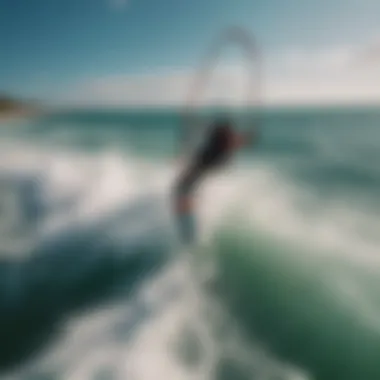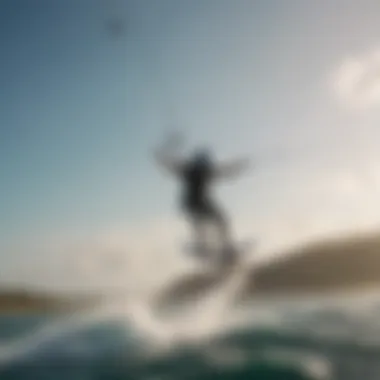Unlock the Secrets of Kitesurfing and Kiteboarding Mastery


Techniques and Tutorials
Navigating the world of kitesurfing and kiteboarding requires mastering a spectrum of techniques, from fundamental basics to advanced maneuvers that push the boundaries of skill and adrenaline. Beginners are guided through step-by-step tutorials that cover essential skills such as launching the kite, controlling direction while riding, executing smooth turns, and landing safely. These foundational techniques lay the groundwork for novice riders to build confidence and proficiency, ensuring a smooth progression in their kitesurfing journey.
For experienced enthusiasts craving a challenge, advanced skills take center stage, offering a repertoire of complex maneuvers that showcase finesse and daring. Jumping techniques propel riders into the air with controlled height and landing, adding an element of aerial acrobatics to their sessions. Tricks like backrolls, kiteloops, and board-off maneuvers challenge riders to push their limits and explore the fullest potential of kitesurfing and kiteboarding. Wave riding and freestyle techniques round out the advanced skills segment, inviting riders to harness the power of the wind and waves in exhilarating displays of agility and creativity.
Introduction to Kitesurfing and Kiteboarding
As we embark on this journey into the realm of kitesurfing and kiteboarding, it is vital to grasp the significance and allure of these exhilarating water sports. Both kitesurfing and kiteboarding offer a unique blend of adrenaline-fueled excitement and technical finesse, attracting enthusiasts of all levels to conquer the wind and waves with skill and precision. Understanding the foundational aspects of kitesurfing and kiteboarding sets the stage for a fulfilling and immersive experience on the water, from mastering basic maneuvers to pushing the boundaries of extreme tricks.
History and Evolution of Kitesurfing
Origins of Kitesurfing
Delving into the origins of kitesurfing unveils a rich tapestry of innovation and adventure. The roots of kitesurfing can be traced back to the late 20th century, where adventurous souls sought to harness the power of the wind with a surfboard and kite. The fusion of sailing and surfing techniques birthed a new watersport that offered a thrilling alternative to traditional water activities. The raw energy and freedom associated with kitesurfing's origins continue to captivate enthusiasts worldwide, making it a cornerstone of modern water sports culture.
Technological Advances in Kitesurfing Gear
The evolution of kitesurfing gear has been marked by leaps and bounds in technological innovation. From the development of more efficient kite designs to the introduction of durable and lightweight materials, kitesurfing gear has undergone a remarkable transformation over the years. These technological advancements have not only enhanced performance and safety but have also opened up new possibilities for riders to explore and expand their skills on the water. Embracing the latest in kitesurfing gear technology is essential for maximizing your experience on the water and staying ahead in this dynamic and ever-evolving sport.
Kiteboarding vs. Kitesurfing: Understanding the Difference
To truly grasp the essence of kitesurfing and kiteboarding, one must unravel the nuanced differences between these two interconnected disciplines. Kiteboarding typically refers to riding a kite on a smaller board with foot straps, allowing for dynamic aerial maneuvers and freestyle tricks. On the other hand, kitesurfing often involves a larger board without foot straps, emphasizing wave riding and fluid transitions on the water. Understanding the distinctions between kiteboarding and kitesurfing lays the foundation for choosing the right equipment, refining your technique, and ultimately immersing yourself in the exhilarating world of wind and waves.
Essential Gear and Equipment
In the realm of kitesurfing and kiteboarding, the significance of essential gear and equipment cannot be overlooked. These tools serve as the pillars of safety and performance while engaging in these high-octane water sports. The right gear can make a monumental difference in skill progression and overall enjoyment. Prioritizing quality gear ensures a smoother learning curve and enhanced experiences on the water, making it a foundational aspect of mastering kitesurfing and kiteboarding.


Kite Selection and Characteristics
Types of Kites
Types of kites play a crucial role in determining the performance and versatility of a kitesurfing setup. From inflatable LEI kites to foil kites, each type offers distinct advantages suited to varying conditions and rider preferences. Inflatable kites are popular for their ease of relaunch and stability, making them a favored choice for beginners and freestyle enthusiasts. On the other hand, foil kites excel in light wind scenarios, providing exceptional efficiency and speed. Understanding the strengths and weaknesses of each kite type empowers riders to select the most suitable option based on their skill level and intended riding style.
Factors to Consider When Choosing a Kite
When choosing a kite, several factors come into play to ensure an optimal match for individual needs. Considerations such as kite size, aspect ratio, and bridle configuration influence performance characteristics like power delivery, wind range, and responsiveness. Additionally, factors like bar feel, canopy material, and depower range impact handling and control, determining the kite's suitability for various conditions. By meticulously assessing these factors, riders can pinpoint a kite that aligns with their riding objectives, whether it be boosting big airs, cruising waves, or mastering technical maneuvers.
Board Varieties and Maintenance
Types of Kiteboards
Kiteboards come in diverse shapes and sizes, catering to different riding styles and conditions. Twin tips are versatile boards suitable for freestyle tricks and casual cruising, offering easy maneuverability and forgiving characteristics. Directional boards, such as surfboards or foil boards, excel in wave riding and light wind performance, capitalizing on agility and speed in dynamic water environments. Selecting the right kiteboard type is paramount in enhancing rider progression and unlocking new possibilities on the water.
Tips for Board Care and Maintenance
Proper maintenance of kiteboards prolongs their lifespan and ensures optimal performance. Regularly inspecting boards for signs of wear and tear, such as delamination or cracks, is essential to prevent performance degradation and safety risks. Implementing protective measures like rail tape and board bags safeguards boards from scratches and impact damage during transport and storage. Additionally, maintaining fin systems and foot straps, and addressing minor repairs promptly, keeps boards in peak condition for extended sessions on the water, fostering a seamless kitesurfing and kiteboarding experience.
Techniques and Skills Development
In this section of the ultimate guide to kitesurfing and kiteboarding, we delve into the essential aspect of Techniques and Skills Development. Understanding and honing these skills are paramount for enthusiasts as they progress in mastering the art of riding the wind. Techniques and Skills Development encompass a wide range of maneuvers and tricks that not only enhance performance but also ensure safety on the water. From basic maneuvers to advanced tricks, building a strong foundation in these skills is key to becoming a proficient kitesurfer.
Basic Kitesurfing Maneuvers
Body Dragging:
Body Dragging holds a pivotal role in the learning journey of kitesurfers. It involves using the power of the kite to navigate through the water without the board. This maneuver is crucial for practicing control and maneuverability in different wind conditions. Body Dragging allows riders to experience the power of the kite firsthand, helping them understand how to harness its force efficiently. Although challenging for beginners, mastering Body Dragging provides invaluable experience and builds confidence in handling the kite effectively.


Water Starts:
Transitioning from Body Dragging to Water Starts marks a significant milestone in a kitesurfer's progression. Water Starts refer to the technique of getting up on the board and riding after being in the water. This maneuver requires a combination of kite control, balance, and timing to successfully lift out of the water and start gliding on the board. Developing proficiency in Water Starts leads to smoother transitions and longer rides, enhancing the overall kitesurfing experience. While mastering Water Starts may take time and practice, it significantly contributes to the fluidity and gracefulness of a kitesurfer's movements on the water.
Advanced Tricks and Stunts
Jumping Techniques:
Exploring the realm of advanced kitesurfing, Jumping Techniques add an exhilarating dimension to the riding experience. Jumping involves launching oneself off the water's surface with the help of the kite's lift. Perfecting Jumping Techniques requires precision in timing, kite control, and body positioning to achieve impressive heights and durations in the air. Besides offering a thrilling sensation, jumping enhances a kitesurfer's aerial control and maneuvering capabilities, setting the stage for more complex stunts and maneuvers.
Wave Riding Skills:
For kitesurfers seeking thrills in challenging conditions, Wave Riding Skills are essential for conquering surfs and swells. Wave Riding involves harnessing ocean waves to glide and perform maneuvers while riding the kite. Mastering Wave Riding Skills demands a deep understanding of wave dynamics, board control, and kite manipulation to navigate through turbulent waters with agility and finesse. Developing proficiency in Wave Riding not only amplifies the kitesurfing experience but also opens doors to a world of creativity and expression on the waves.
Safety Measures and Guidelines
In this section, we delve into the critical topic of Safety Measures and Guidelines within the realm of kitesurfing and kiteboarding. Safety is paramount in these extreme sports, considering the dynamic nature of wind and water environments. A thorough understanding and adherence to safety measures not only protect the riders but also those around them. It is crucial to be equipped with the knowledge and skills necessary to navigate potential risks effectively. We will explore various safety protocols, equipment checks, and best practices to ensure a safe and enjoyable kitesurfing or kiteboarding experience.
Understanding Wind Conditions
Wind Speed and Direction
The wind's speed and direction play a pivotal role in determining the feasibility and excitement of kitesurfing and kiteboarding activities. Understanding these aspects is vital for harnessing the wind's power effectively. Wind speed dictates the force with which the kite propels the rider, influencing speed and maneuverability. Directionality impacts the angles at which riders can execute tricks and navigate the water. Mastering the nuances of wind speed and direction allows kitesurfers and kiteboarders to optimize their performance while staying safe on the water.
Reading Wind Patterns
Interpreting wind patterns is a skill that separates seasoned riders from beginners. Adeptly reading wind patterns enables riders to anticipate gusts, lulls, and shifts in direction, aiding in strategic decision-making on the water. Identifying turbulent areas or pockets of stable wind can enhance the riding experience and prevent potential pitfalls. By delving into the intricacies of wind patterns, riders can adapt their techniques and routes, capitalizing on optimum wind conditions.
Emergency Protocols and Rescue Techniques


Self-Rescue Procedures
Self-rescue procedures are indispensable skills for kitesurfers and kiteboarders, empowering them to handle emergencies autonomously. Understanding how to react in case of equipment failure, loss of wind power, or other unforeseen circumstances is essential for personal safety. Self-rescue protocols involve deploying safety systems, managing the kite, and utilizing available resources to reach shore safely. By mastering self-rescue techniques, riders can mitigate risks and promptly address emergencies, showcasing their self-reliance and preparedness.
Assisting Other Riders in Distress
In the event of a fellow rider encountering trouble on the water, being adept at assisting others in distress is a mark of camaraderie and responsibility in the kitesurfing and kiteboarding community. Implementing effective rescue techniques, communicating clearly, and coordinating efforts with other riders can be instrumental in ensuring a swift and successful rescue operation. Collaborative rescue endeavors not only enhance safety standards but also foster a sense of unity and support among riders. By honing rescue skills, riders contribute to a culture of vigilance and mutual aid, elevating the collective safety of the kitesurfing and kiteboarding community.
Exploring Kitesurfing Destinations
When delving into the intricacies of kitesurfing and kiteboarding, exploring kitesurfing destinations emerges as a crucial aspect for enthusiasts seeking new challenges and experiences. The choice of destination can significantly impact the quality of the kitesurfing adventure. Factors like wind conditions, water terrain, and local amenities play vital roles in determining the suitability of a spot for kitesurfing. Selecting the right destination enhances the overall kitesurfing experience and allows riders to test their skills in diverse and exciting environments.
Top Kitesurfing Spots Around the Globe
Caribbean Gems
Caribbean Gems stand out as coveted kitesurfing destinations renowned for their stunning turquoise waters, consistent trade winds, and warm tropical climate. This region offers ideal conditions for both novice and experienced kitesurfers, making it a preferred choice for those seeking thrilling sessions on the water. With a wide array of kite schools, rental facilities, and accommodation options, Caribbean Gems ensure a seamless kitesurfing experience. However, crowded beaches during peak seasons and occasional wind lulls might pose minor limitations to riders.
European Hotspots
European Hotspots boast a diverse range of kitesurfing destinations, from the rugged coastlines of Portugal to the picturesque beaches of Greece. Each spot in Europe offers unique characteristics, such as varying wind patterns, wave conditions, and cultural experiences. European Hotspots cater to kitesurfers of all levels, providing ample opportunities for progression and skills enhancement. While accessibility and infrastructure are generally favorable, some spots may experience overcrowding during peak tourist seasons.
Asian Paradises
Asian Paradises allure kitesurfers with their pristine beaches, warm hospitality, and uncrowded kite spots. From the tropical escapades in the Philippines to the hidden gems of Vietnam, Asia provides a tranquil setting for kitesurfing enthusiasts looking to immerse themselves in nature. Asian Paradises offer a respite from the hustle and bustle of city life, allowing riders to connect with the elements in a serene environment. However, limited infrastructure in some locations and language barriers can present challenges to travelers seeking an off-the-beaten-path experience.
Travel Tips for Kitesurfers
Packing Essentials
Packing Essentials constitute a critical aspect of preparing for a kitesurfing trip, ensuring that riders have all necessary gear and equipment for a successful adventure. Essential items include kites, boards, harnesses, wetsuits, sunscreen, and first aid kits. Efficient packing not only enhances safety on the water but also contributes to a more organized and enjoyable kitesurfing experience. However, overpacking can lead to cumbersome travel arrangements and excess baggage fees, highlighting the importance of packing strategically and prioritizing essentials.
Visa and Entry Requirements
Visa and Entry Requirements play a pivotal role in facilitating seamless travel for kitesurfers exploring international destinations. Understanding visa regulations, entry permits, and travel insurance requirements is essential to avoid any last-minute complications during the journey. Reliable information on visa processing times, validity periods, and visa extension procedures is imperative for kitesurfers planning extended trips. However, incomplete documentation or visa restrictions can disrupt travel plans, underscoring the significance of thorough preparation and adherence to local regulations.







